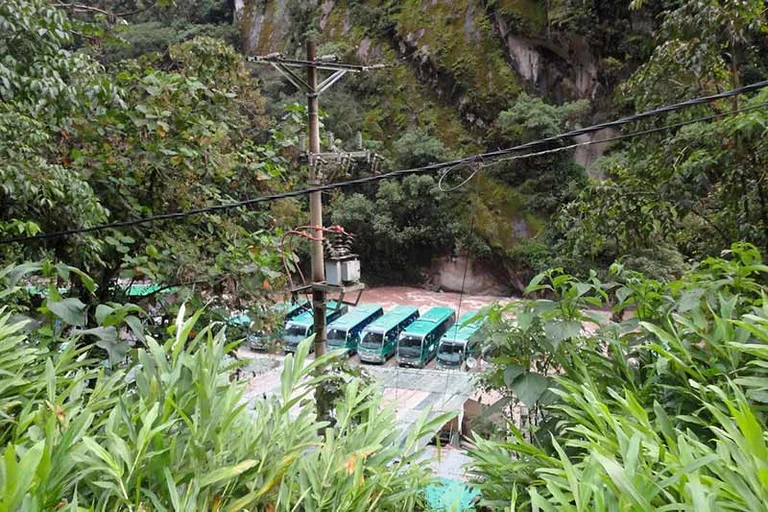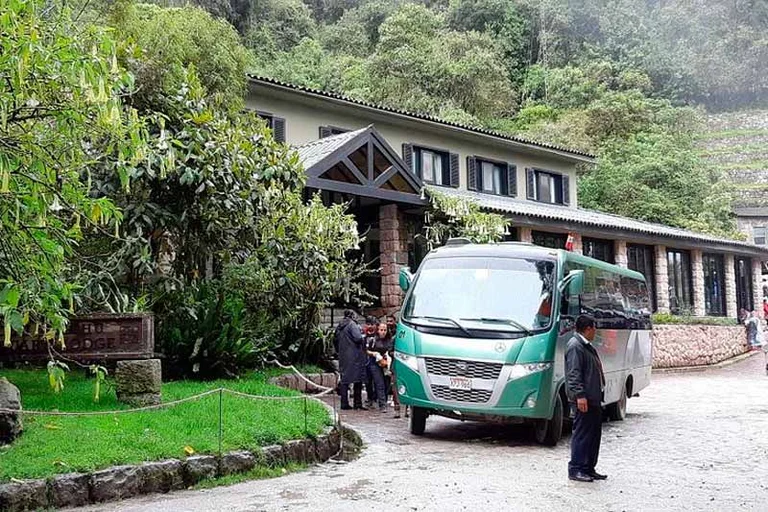Everything you need to know about your bus trip to Machu Picchu
Machu Picchu is one of the most visited destinations in the world. Every year, thousands of travelers arrive in Aguas Calientes, the base town, from where they take a bus to cover the final stretch to the citadel. This 30-minute journey offers breathtaking views of the jungle and mountains, creating a unique experience that prepares visitors for the majesty of Machu Picchu. Although there is a way to access it on foot, the bus service has become the most comfortable and popular option. Discover all the details and logistics every visitor should know before embarking on this adventure.

Content
- Operation of the Bus System
- Transportation System
- Eco-friendly Buses
- Transportation Discounts
- Biodiversity Along the Route
- Frequently Asked Questions
Operation of the Bus System
The transportation service to Machu Picchu is managed by the company Consettur, which holds the exclusive concession to operate on the route. The buses begin running in the early hours of the morning, allowing travelers to reach the citadel before sunrise, a privileged moment to enjoy the view without the crowds of tourists.
The buses depart from the station in Aguas Calientes and ascend a route of approximately 9 kilometers to the main entrance of Machu Picchu. The journey lasts between 25 and 30 minutes and passes through a series of curves that offer breathtaking views of the Urubamba River and tropical vegetation. Buses leave Aguas Calientes every 10 minutes starting at 5:30 a.m., allowing travelers to board any available unit with their ticket, without the rigidity of a fixed schedule. It is important to keep in mind that the last bus to Machu Picchu departs at 3:30 p.m., so it is advisable to plan the day in advance to make the most of the service.
On the return trip, the route is similar, but the difference lies in the arrival stop when traveling from Machu Picchu to Aguas Calientes. This departure point is just a few steps from the main entrance of the citadel, providing great convenience and ease for visitors seeking transportation back.
Bus Discounts to Machu Picchu
Take advantage of discounts and experience the magic of Machu Picchu without worrying too much about your budget! If you’re traveling with children or are a Peruvian citizen, check out the special rates and secure your spot in advance. Submit the required documentation and get ready for an unforgettable experience at one of the world’s most spectacular wonders. Don’t miss this opportunity to enjoy Machu Picchu at preferential rates!
Transportation System

The Hiram Bingham road, which today connects Aguas Calientes with Machu Picchu, was built in the 1940s as part of the Peruvian government’s tourism infrastructure plan. Its zigzag design was necessary to minimize the impact on the mountainous terrain and protect the ecosystem of the Machu Picchu Historic Sanctuary. Since then, the operation of the buses has evolved to meet the growing demand from tourists.
Eco-friendly Buses
One of the most notable features of the transportation system to Machu Picchu is its commitment to sustainability. The eco-friendly buses operating on this route have been designed to minimize environmental impact in such a sensitive area as the Machu Picchu Historic Sanctuary. Below are some key aspects of these vehicles:
- Low-emission technology: Eco-friendly buses incorporate modern engines that significantly reduce the emission of particles and polluting gases. Additionally, hybrid models and, in some cases, electric vehicles are being implemented, marking an important step towards cleaner transportation.
- Reduced impact on the ecosystem: By lowering emissions, these vehicles help maintain air quality and preserve the area’s biodiversity. This is crucial for protecting both local flora and fauna, ensuring that tourism develops in a way that respects the natural environment.
- Regulatory and compliance commitment: The government, in collaboration with environmental authorities, has established strict regulations to ensure that vehicles operating on the route meet high ecological standards. These regulations include periodic inspections and the promotion of clean technologies, benefiting both public health and the environment.
- Future vision: The implementation of eco-friendly buses is just the beginning of a long-term strategy to promote sustainable tourism. Over time, these initiatives are expected to expand, encouraging more operators to adopt green technologies and contributing to a tourism model that respects and protects this natural and cultural heritage.
Are there other ways to get to Machu Picchu?
While the bus is the fastest and most convenient option, there are alternatives for those looking for a more economical experience or who simply prefer to walk. One of the most popular options is the steep hiking trail near the road, which takes between 1.5 and 2 hours to ascend, depending on the individual’s pace. This trail allows for a closer connection with nature and is ideal for those who want to save money on transportation.
Transportation Discounts

- Free travel for children aged 0 to 4: The youngest travelers (ages 0 to 4) can ride the bus to Machu Picchu free of charge. However, keep in mind that these children will not have their own seat and must sit on their parents’ or guardians’ laps for the entire journey.
- Discount for children aged 5 to 11: Children between the ages of 5 and 11 are eligible for a special bus fare. Please ensure you have their National Identity Document (DNI) or valid foreign resident card at all times to verify their age and apply the discount.
- Discount for Peruvians: Peruvian citizens also receive a special discount. To take advantage of this benefit, they must present their National Identity Document (DNI) or valid foreign resident card when purchasing the bus ticket, ensuring a preferential rate for nationals.
Biodiversity Along the Route
The bus ride from Aguas Calientes to Machu Picchu is more than just transportation; it is a visual experience that immerses you in the unique beauty of the landscape. During these 9 kilometers of road, you will enjoy:
- Spectacular Panoramas: As the bus ascends, the landscape transforms before your eyes. From vast valleys covered in vegetation to towering mountain peaks, every turn in the road offers a new perspective of the area’s natural beauty.
- The Urubamba River: This river, which flows along the route, adds a magical touch to the journey. Its course, sometimes visible through the dense vegetation, serves as a reminder of the environment’s vitality and importance.
- Flora and Fauna: Along the route, you will have the chance to observe the diversity of Andean flora, with trees, ferns, and orchids appearing at every turn. The fauna, though more elusive, may reveal itself if you pay close attention.
